|
Vietnam's total export value of livestock products in September 2023 reached 14.8 million USD, a decrease of 25.3% over the previous month and an increase of 52.8% over the same period in 2022. In September 2023, meat of swine, fresh, chilled or frozen; other prepared or preserved meat, meat offal or blood; and meat and edible meat offal, salted, in brine, dried or smoked - edible flours and meals of meat or meat offal were Vietnam's main export livestock products with value of 5.06 million USD, 3.56 million USD, and 2.09 million USD, respectively. Besides, there was no recorded export of live bovine animals (HS 0102) in September from Vietnam. Hong Kong and ASEAN are Vietnam's largest export markets, with export values of 51.8 million USD and 29.2 million USD respectively in the first 9 months of 2023. Exports to Australia during the same period only reached 94 thousand USD, which accounted for only 0.07% of Vietnam's total livestock exports, an increase of 9% compared to the first 9 months of 2022. Meat of swine, fresh, chilled or frozen is one of the main export products in September 2023. Of which, Hong Kong is the main export market, accounting for 98% of total export value. Vietnam imported livestock products worth $168.5 million in September 2023, a 0.2% increase from the previous month but a 4.4% decrease from the same period in 2022. In September 2023, meat of bovine animals, frozen and meat of swine, fresh, chilled or frozen are the two most imported livestock products with values of 63.7 million USD and 33.5 million USD, respectively. However, imports of meat of bovine animals (fresh or chilled) almost halved compared to the previous month. Live bovine animals export was valued at 13 million, also showing a significant decrease in the value by 52% compared to the previous month. In the first 9 months of 2023, India and Australia were the two largest livestock product supply markets for Vietnam, with import values of 352 million USD and 214 million USD, respectively. Compared to the first 9 months of 2022, imports from India decreased by 7% and imports from Australia increased by 23%. Live bovine animals and fresh, chilled, or frozen meat (bovine meat and pork) were the main imported items in September. Almost 100% of the live cattle were sourced from Australia in September. As for meat, 76.4% of fresh or chilled meat of bovine animals originated from Australia. India was the main import source for frozen meat of bovine animals, accounting for 76.2%. In September 2023, Vietnam's imports of livestock products from Australia reached 25 million USD. Of which, live bovine animals and meat of bovine animals, frozen were the most imported products, with import values of 13 million USD and 7.3 million USD, respectively. Vietnam's import value of beef and cattle from Australia in September 2023 was 23.2 million USD, a decrease of 40.3% from the previous month, but an increase of 11% compared to the same period in 2022. From January to September 2023, the most imported product was live bovine animals (not for breeding), with an import value of 129 million USD. This figure represents a 61% increase over the same period last year. However, the import value of other products such as meat of bovine animals, fresh or chilled, and edible offal of bovine animals, fresh or chilled, decreased.
During week 43, the price of beef thighs experienced a significant drop to 196,000 VND per kilogram. This marks a 4.6% decrease compared to the previous week and is also the lowest price observed so far in 2023. The price of beef fillet observed a minor decrease of 0.6% compared to the previous week, reported at 226,000 VND per kilogram in Week 43. In week 43, the average price of live-weight cattle was 85,000 VND/kg, down 1.2% compared to week 42. In terms of the current number of cattle handled in the facilities (feedlot or abattoir), the smallest feedlot had 100 heads of cattle whereas the biggest had 8000 animals in their feedlot. Similarly, the smallest abattoir slaughtered 7 animals (week 40) and 5 animals in a day (week 42) whereas the biggest slaughtered 30 animals in a day.
Live cattle selling prices were stable from weeks 40 to 42 except for BBB cattle breeds in South and Central Highlands. In the South, BBB cattle breed price went up by 2,000 VND/kg, and in the Central Highlands, it went down by 5,000 VND/kg.
In week 44, the price of Vietnamese beef at supermarkets remained unchanged compared to the previous week, the highest price of beef fillet at Co.op Mart was 380,000 VND/kg, and the lowest price at Winmart was 358,000 VND/kg.
Prices of Australian beef in Week 44 remained unchanged compared to the previous week except short plate Kiaora beef which increased to 385,000 VND per kg.
0 Comments
In week 42, the average price of beef thigh decreased compared to week 41 to 205,000 VND/kg, down 4.4% and the lowest so far of all weeks, this year. The average price of beef fillet increased slightly by 2.2% from 222,500 VND/kg (week 41) to 227,444 VND/kg (week 42). In week 42, the average price of live-weight cattle remained steady at 86,000 VND/kg, unchanged compared to week 41. Regionally, in week 42, the price of live cattle in the North was higher than in other regions. For BBB Beef, the lowest price recorded in all three regions was 77,000 VND/kg, while the highest price was observed in the North at 85,000 VND/kg. The price of local cattle was comparatively lower by around 10-17,000 VND/kg than that of BBB cattle. The lowest price for local cattle was recorded in the Central Highlands at 60,000 VND/kg and the highest in the North and South at 70,000 VND/kg. In week 43, the prices of Vietnamese beef at all supermarkets did not change compared to week 42. These prices have been maintained relatively stable in the last 4 weeks. Like Vietnamese beef, the prices of imported Australian beef are also stable at most supermarkets, except for Winmart supermarket, which quoted the price of Beef short plate Kiaora down 13% to 335,000 VND/kg and the price of Brisket Navel End Pacow up 10% to 428,000 VND/kg. In week 41, the average prices of beef thigh and beef fillet decreased compared to the previous week, especially the price of beef thigh decreased for 4 consecutive weeks. The average price of beef thigh was 215,000 VND/kg, down 3.6% and the average price of beef fillet was 222,500 VND/kg, down 5.3% compared to week 40. Both the average price of beef thigh as well as beef fillet were the lowest recorded average prices of the year so far. The average price of live weight cattle in week 41 slightly increased, this is also the highest price since September 2023 and one of the highest average prices of the year. However, the average weekly prices were relatively stable so far throughout the year ranging between 80,000 – 86,625 VND/kg. The average price of live weight cattle in Week 41 was 86,000 VND/kg, up 4.9% compared to week 40. In week 42, Vietnamese beef prices were stable at most supermarkets, except for GO supermarket meat, which reported a slight increase in beef fillet prices by 1,000 VND/kg and beef shank prices by 2,000 VND/kg compared to week 41. In week 42, Australian beef prices remained unchanged at most supermarkets, except at Winmart supermarket. The price of Brisket Navel End Pacow decreased from 424,000 VND/kg (week 41) to 388,000 VND/kg (week 42) and the price of Beef short plate Kiaora increased from 338,000 VND/kg (week 41) to 385,000 VND/kg (week 42). In week 40, the average price of beef thigh decreased sharply compared to week 39 to only 223,000 VND/kg, down 10.1%, and around the same price as in the weeks of April 2023. The average price of beef fillet increased slightly by 1.7% from 231,000 VND (week 39) to 235,000 VND/kg (week 40). The average price of live weight cattle showed a decreasing trend from the last weeks of September. In week 40, the average price of live weight cattle was 82,000 VND/kg, down 1.2% compared to week 39. Regionally, in week 40, the price of live cattle in the North was higher than in other regions. For BBB Beef, the lowest price was recorded in the South at 77,000 VND/kg, while the highest prices were observed in the North and Central Highlands, both at 84,000 VND/kg. The price of local cattle was comparatively lower by around 10-12,000 VND/kg than that of BBB cattle. The lowest price for local cattle was recorded in the South and Central Highlands, both at 60,000 VND/kg, and the highest in the North at 74,000 VND/kg. In week 41, Vietnamese beef prices remained unchanged at the supermarkets. The highest price of beef shank was reported at Go Mart at 385,000 VND/kg, while the highest price of beef fillet was at 380,000 VND/kg at Co.op Mart. In week 41, imported Australian beef prices were stable at most supermarkets, except for Beef Short Plate Kiaora price decrease and Brisket Navel End Pacow price increase at Winmart supermarket compared to week 40. Vietnam's total export value of livestock products in August 2023 reached 19.8 million USD, an increase of 41.6% over the previous month and 62.7% over the same period in 2022. In August 2023, live bovine animals; meat of swine, fresh, chilled or frozen; other meat and edible meat offal, fresh, chilled or frozen; and other prepared or preserved meat, meat offal or blood were Vietnam's main export livestock products with value of 5.03 million USD, 4.77 million USD, 3.8 million USD, and 3.4 million USD, respectively. Hong Kong and ASEAN nations were the two largest export markets, accounting for export values of USD 46.0 million and USD 28.2 million during the first 8 months (Jan-Aug) of 2023. Exports to Australia hold a share of only 0.1% of the total exports of livestock products from Vietnam. Live bovine animals constitutes one of the major export items in the month of August. Laos and Cambodia were the major markets of live bovine exports with a share of 39.4% and 60.6%, respectively. Vietnam's total import value of livestock products in August 2023 reached 168 million USD, up 9.9% over the previous month and down 0.2% over the same period in 2022. In August 2023, frozen meat of bovine animals valued at USD 55.4 million and live bovine animals valued at USD 27 million were among the top 3 imports of livestock products. India and Australia were the two largest market for imports to Vietnam, accounting for import values of USD 300 million and USD 189 million during the 8 months of this year (Jan-Aug 2023). It indicates a fall of 12% for India in 2023 compared to the same period of first 8 months in 2022 and a rise of 25% for Australia for the same period. Live bovine animals and meat of bovine animals, both fresh or chilled and frozen, constitute the major import items in the month of August. Australia was the main source of live bovine animals. For meat of bovine animals, Australia was the main source for fresh or chilled meat (83%) and India for frozen meat (74.1%). In August 2023, Vietnam's imports of livestock products from Australia reached 40 million USD, indicating an increase by around a third as compared to the import values in the previous month (July). Of which, live bovine animals, fresh or chilled meat of bovine animals, and frozen bovine meat were the most imported products, with import values of USD 18.5 million, 1.3 million and 6.7 million, respectively. In August 2023, Vietnam's beef and cattle import value from Australia reached $38.9 million, marking a 32.4% increase compared to August 2022. Over the first 8 months of 2023, live bovine animals (cattle - not for breeding) was the most imported product, with a total import value of $116 million, representing a year-on-year increase of 63%. However, other products such as the meat of bovine animals, frozen; and fresh/chilled/frozen edible offal of bovine animals, swine, etc., experienced a decrease in import values. In August, most live cattle and beef products imported from Australia saw significant growth compared to July. Products that recorded strong growth included live cattle (up 46%), frozen boneless meat (up 20%), and fresh/chilled boneless meat (up 34%), etc. The average import prices of live cattle and frozen boneless bovine meat increased in August compared to the previous month (July) in 2023. Prices of other meat of bovine animals decreased in August compared to July 2023. The top 2 importing companies imported a little over half of all cattle and beef products from Australia in August 2023. In week 38, the price of beef thigh dropped to 260 thousand VND/kg, down 7% compared to week 37. Meanwhile, beef fillet increased slightly by 2% compared to week 37 at 255 thousand VND/kg. In week 38, the average price of live weight cattle was at 84 thousand VND/kg, up 1% compared to week 37. In terms of the current number of cattle handled in the facilities (feedlot or abattoir), the smallest feedlot had 100 heads of cattle whereas the biggest had 8000 animals in their feedlot. Similarly, the smallest abattoir slaughtered 7 animals in a day whereas the biggest slaughtered 30 animals in a day.
The available selling prices of hot beef remained unchanged between Week 36 and Week 38. Prices of Cambodian cattle in Week 38 at the region bordering Cambodia ranged between 48,000 to 50,000 VND/kg for animal weighing around 230 kgs and 58,000 to 60,000 VND/kg for animals weighing around 350 kgs. Slaughter cattle fetched between 66,000 to 67,000 VND/kg for animals weighing around 450-500 kgs while animals weighing between 600-700 kgs fetched around 68,000 to 70,000 VND/kg. In week 39, the price of Vietnamese beef cuts at supermarkets remained unchanged compared to the previous week, except for Winmart supermarket, which reported a decrease in beef fillet prices. In week 39, prices of Australian beef remained relatively steady compared to the previous week, with the exception of beef shank and shoulder clod, which experienced price hikes at Go supermarket, and a decrease in prices for beef sirloin Hokubee at Homefarm supermarket. The average price of beef fillet and beef thigh decreased substantially in week 39. The average price of beef fillet decreased by 9.4% from 255,000 VND/kg (week 38) to 231,000 VND/kg and the price of beef thigh decreased by 4.6% from 260,000 VND/kg (week 38) to 248,000 VND/kg. The beef thigh price was on a downward trend after witnessing the highest average price of the year so far in Week 37. The average price of live-weight cattle in week 39 decreased by 1.2% compared to week 38, from 84,000 VND/kg to 83,000 VND/kg. The current average price is around the same as the starting weeks of the year. In week 40, beef prices at most supermarkets in Vietnam remained stable, except for Go supermarket which increased the price of beef fillet to 365,000 VND/kg while decreasing the price of beef shank to 385,000 VND/kg compared to week 39. In week 40, the prices of Australian beef remained stable at supermarkets, except for brisket navel end Pacow (Winmart) and grilled chuck crest (Home Farm) with reduced prices; and beef shank (Home Farm) and beef sirloin Hokubee (Home Farm) with increased prices compared to week 39. The national average price of beef thigh and fillet in week 37 increased compared to the previous week. Beef thigh was priced at 280,000 VND, up 7.7% and the highest price so far this year. Beef fillet was priced at an average of 250,000 VND, up 0.8% compared to the previous week. The national average price of live cattle in week 37 increased slightly compared to week 36 from 82,000 VND to 83,000 VND, an increase of 1.2%. In the 38th week, beef fillet and beef thigh prices at Go supermarket decreased compared to the previous week, while prices of beef shank at Go supermarket and beef fillet at Winmart increased. Prices for other meats remained unchanged. Australian beef prices in Week 38 at supermarkets remained stable or declined slightly, with the exception of beef shank and Hokube beef sirloin at Homefarm supermarket, which saw a price increase. The average prices of beef fillet (VND 248,000) and beef thigh (VND 260,000) in week 36 (Sep 11-15) showed a slight increase compared to the previous week by 1% and 4%, respectively. The average price of live-weight cattle has continuously decreased for 4 consecutive weeks compared to week 32. The average price of live-weight cattle in week 36 was 82,000 VND/Kg, a decrease of 4% compared to week 35. Prices in supermarkets Compared to last week, retail prices for most Vietnamese beef cuts have stayed the same or decreased in all stores except a slight increase in the price of Beef shank at Go Mart from VND 383,000 in the previous week to VND 385,000 in Week 37. Retail prices in Week 37 for most Australian beef cuts have stayed the same at Home Farm and WinMart but fell for Beef brisket at GO Mart, and beef shank and sirloin at Home Farm compared to the previous week. Prices increased for beef shank and shoulder clod at Go Mart, and short plate Kiaore at WinMart. Supermarkets lowered prices on certain beef items to encourage holiday shopping on September 2 During the National Day holiday of September 2, supermarkets lowered prices on certain beef items. Specifically:
Source: https://kinhtedothi.vn/sieu-thi-dong-loat-giam-gia-thit-lon-thit-bo.html Australian frozen quarter beef exports show signs of growth In August, the bone-in frozen beef category saw Australian exports total 5234 tonnes, more than 5% of total exports for the month, and 35% higher than August two years ago. Dealing in frozen quarter beef may be an attractive option for some beef processors at present, as a means of optimising plant throughput during the current period of high cattle supply pressure and low labour access. Source: https://www.beefcentral.com/news/frozen-quarter-beef-exports-show-signs-of-growth-whats-behind-it/ Tay Ninh province: Farmers are grappling with challenges as cattle prices remain at a low level From the beginning of the year until now, the price of live buffalo and beef cattle in Tay Ninh province continues to decrease compared to the same period in 2022, an average decrease of 15% to 25%, the lowest price in recent years. Consequently, numerous households engaged in buffalo and cattle farming have opted to reduce their livestock numbers to mitigate potential losses. Mr. Duc from Chau Thanh district shared that beef cattle, which is raised for a year and typically sold at an average weight of 250 kg, fetch only around 10 million VND. When considering all the expenses incurred, including insemination, vaccinations for diseases, and feeding, the farmer's profit amounts to less than 3 million VND. Consequently, he would incur financial losses if he purchases cattle for fattening. Mr. Tuan from Trang commune recently sold three beef cattles, with a combined weight of approximately one ton. However, his earnings amounted to slightly less than 60 million VND, a significant decrease from the over 90 million VND he used to receive in previous years. Mr. Tuan emphasized that, in his nearly decade-long experience of cattle farming, he has never witnessed cattle prices plummeting to such an extent as they have now. Mr. Vinh, a resident of Long Phuoc commune, recollected the years when buffaloes and cows held significant value, generating an annual income of nearly 150 million VND for his family. Raising these animals was instrumental in lifting his family and other farming households out of poverty. However, since late 2022 to the present, the prices of buffaloes and beef cattles have witnessed a decline. Concurrently, sourcing fresh grass has become progressively challenging, and rolled straw costs have risen from 25,000 VND per roll to over 40,000 VND. These factors have rendered livestock farming unprofitable. As reported by several traders in Chau Thanh and Ben Cau districts, once the lumpy skin disease epidemic was successfully controlled, the situation regarding buffalo and cow farming in the province began to stabilize and show signs of recovery. Nevertheless, the selling prices continued to decline. At the start of 2022, live buffalo was fetching over 90,000 VND per kilogram, but by the end of the same year, it had dropped to 60,000 VND per kilogram. Similarly, the price of live beef cattle also decreased, falling from 90-93 thousand VND per kilogram to approximately 80 thousand VND per kilogram. There was even a period when the price of live beef cattle dipped below 70,000 VND per kilogram. Nonetheless, despite a significant 45%-50% drop in live cattle prices, leading to financial losses for farmers, the prices of buffalo and beef meat in the markets have remained unchanged. Presently, commercial beef is still priced at 180,000 - 250,000 VND per kilogram, equivalent to previous years. Traders at the Ward 3 market in Tay Ninh city explained that while the price of live buffalo and beef cattle has decreased, other expenses such as labor, slaughtering, and transportation have risen. These additional costs have contributed to the stability of commercial beef prices. Source: https://nhachannuoi.vn/tay-ninh-gia-trau-bo-xuong-thap-nguoi-chan-nuoi-gap-kho/
Vietnamese version The average market price of buffalo fillet in Vietnam has remained relatively stable throughout most of 2023. The average price in Week 35 (VND290,000/kg) has dropped by 0.9 % compared to the previous week. Average beef fillet prices have witnessed a steady decline since the Lunar New Year in February, but the average price in Week 35 (VND235,000/kg) is a slight increase of 0.6 % compared to Week 34. The average national weekly prices of live-weight cattle have been more unstable in recent weeks compared to the initial weeks of the year. Compared to Week 34, the average price in Week 35 (VND83,000/kg) has slightly decreased by 1.2 %. In supermarkets, the beef prices for the week, remained the same or increased compared to the previous week, for all types of beef cuts except at Coop Mart which reported a decrease in prices of Beef Fillet and Brisket Navel End. Retail prices of Australian beef cuts in selected supermarkets have generally either remained the same or increased compared to the previous week.
|


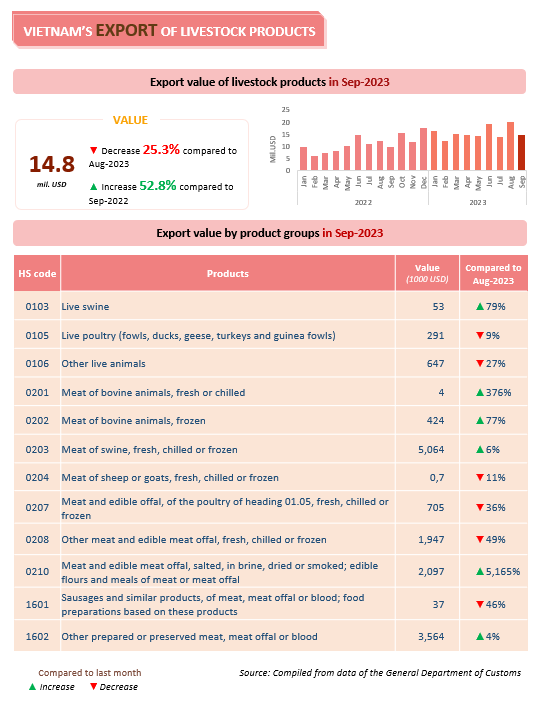
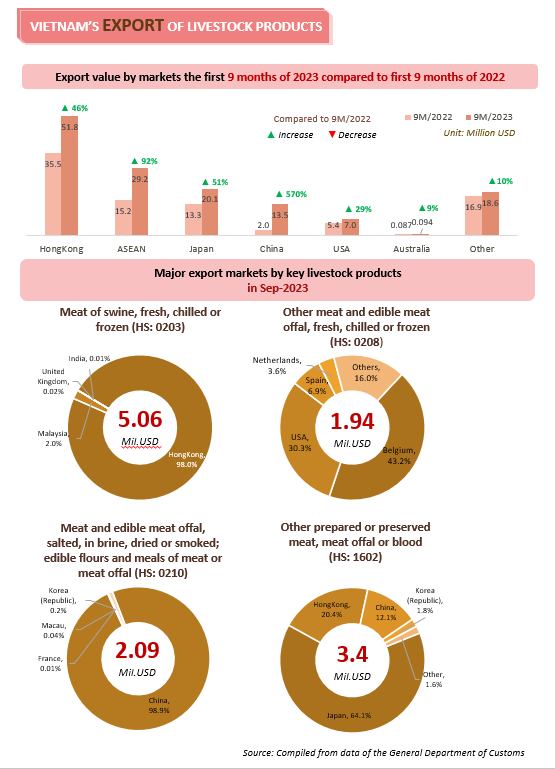


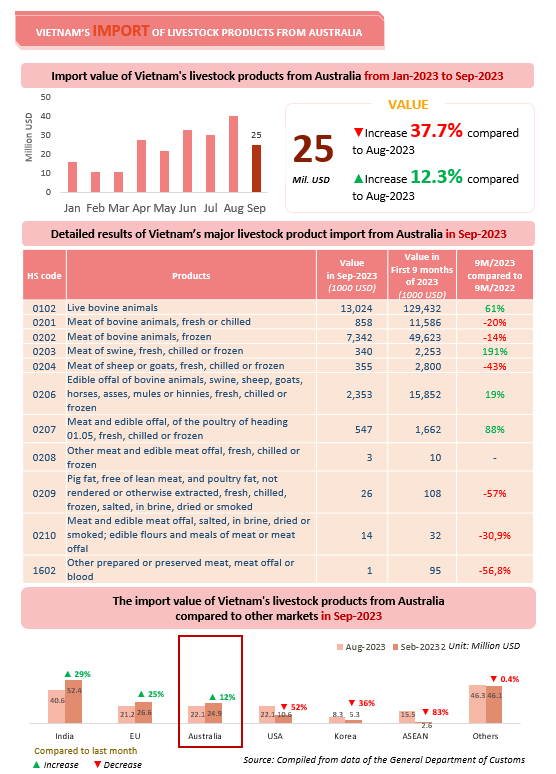
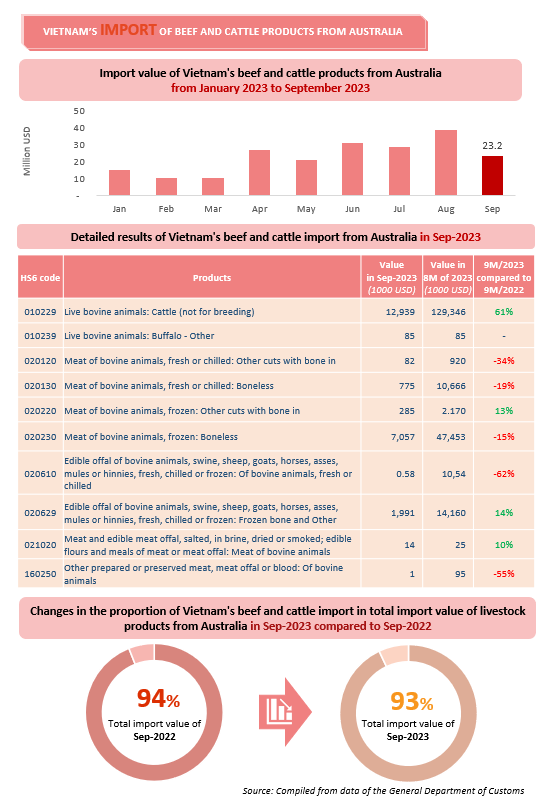



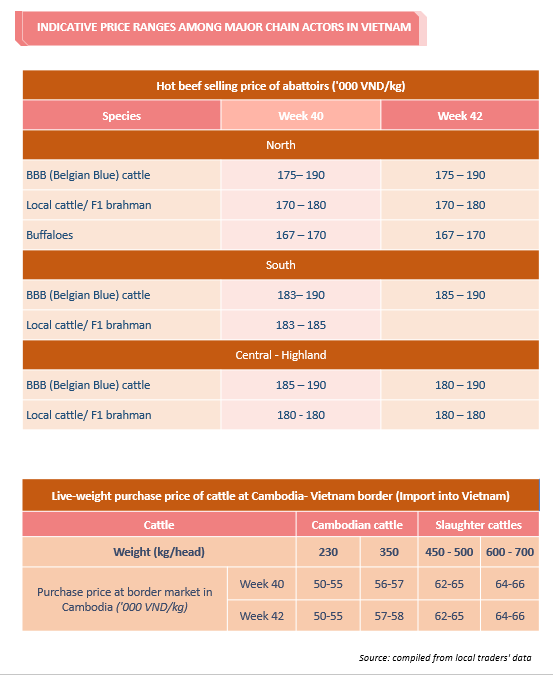


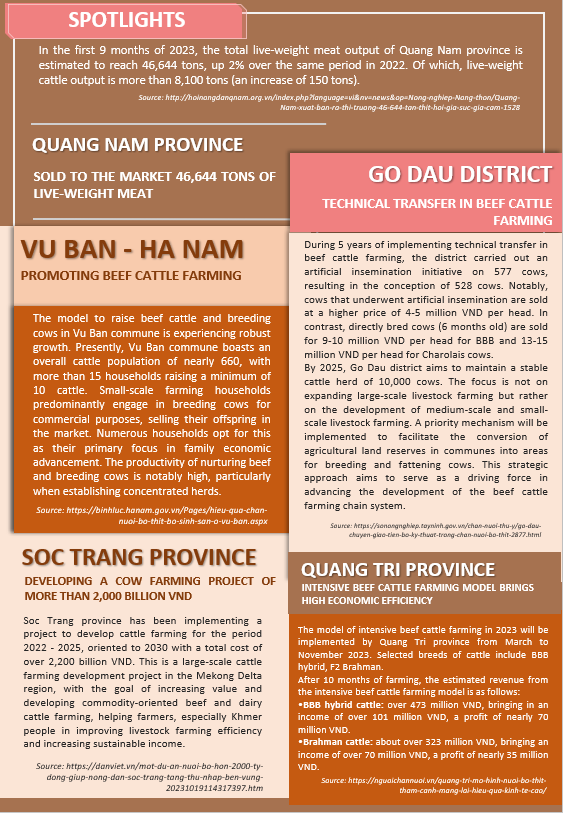
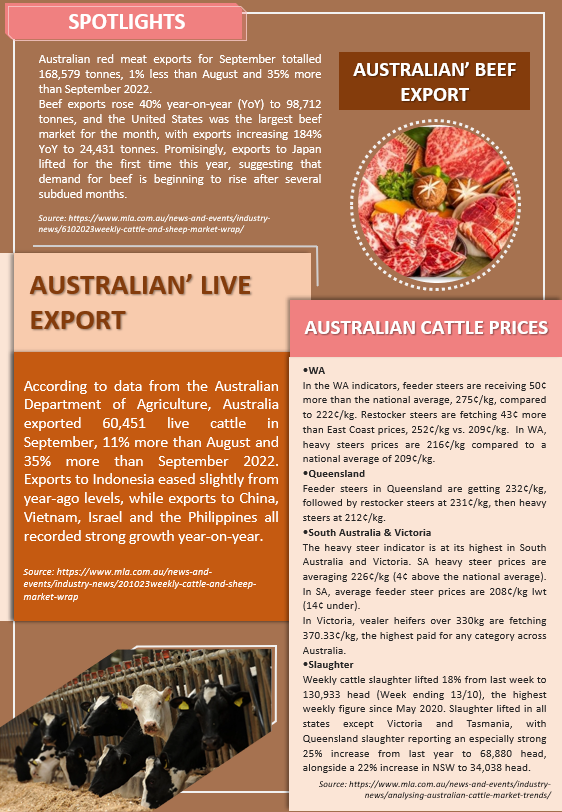
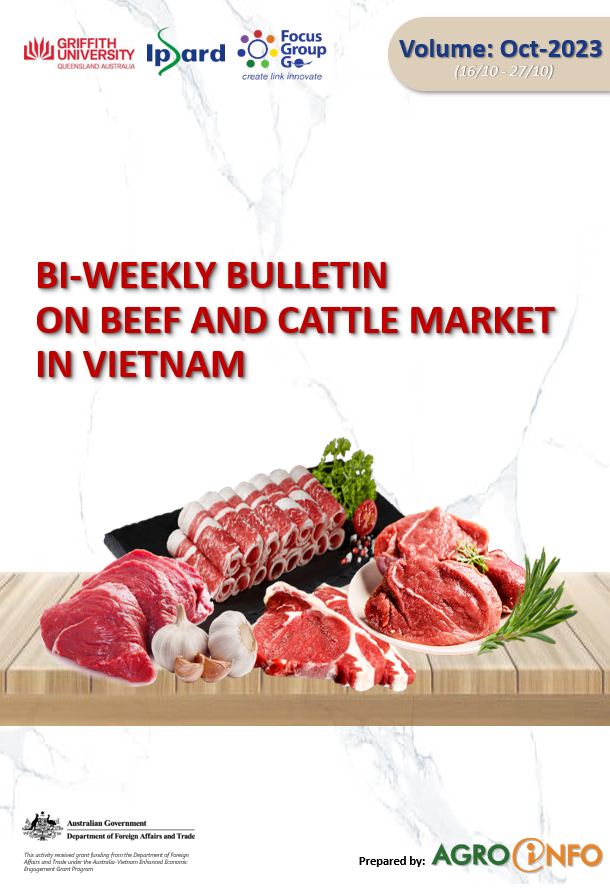
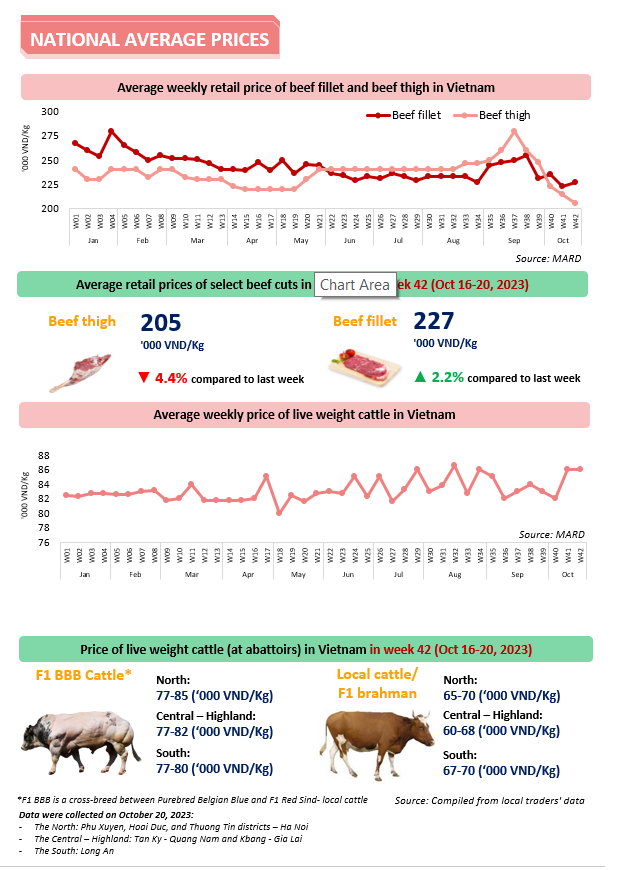
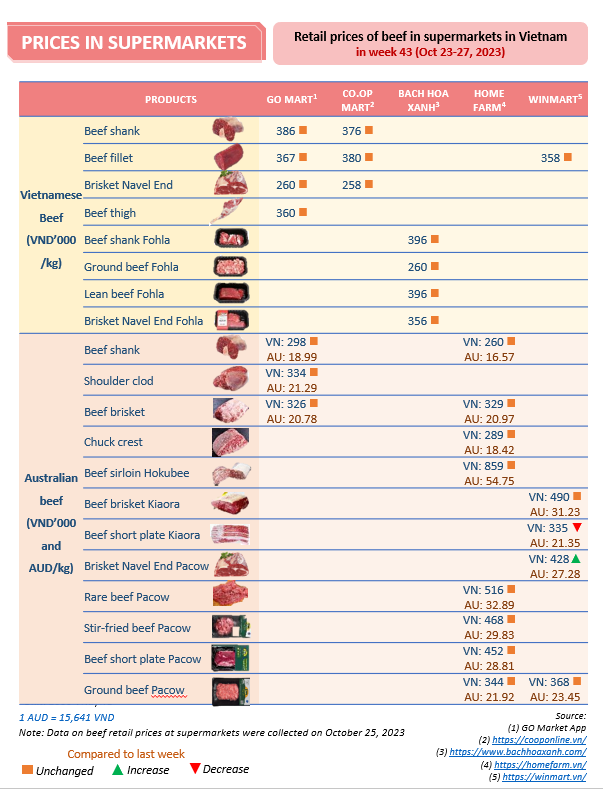

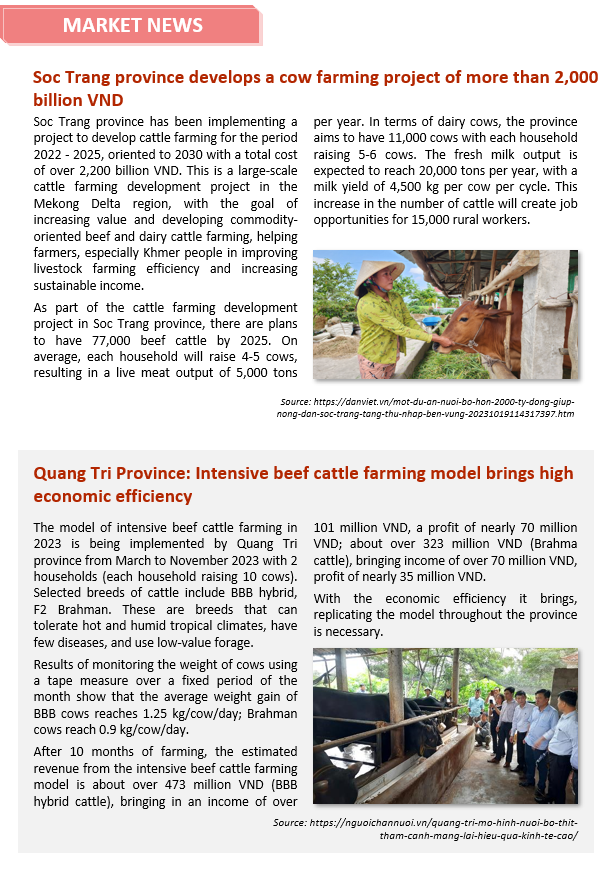
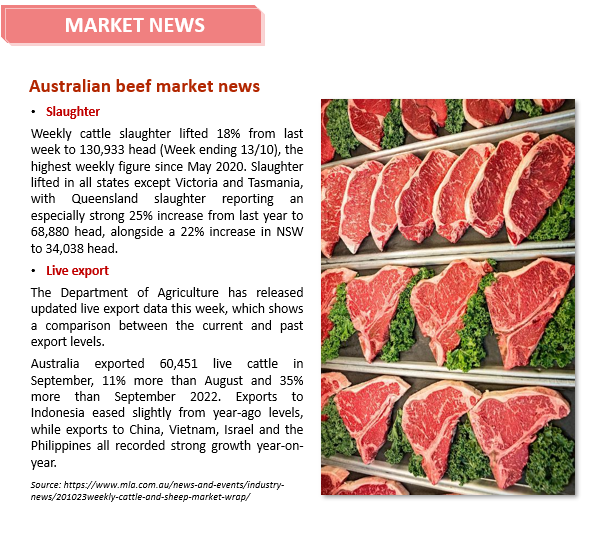
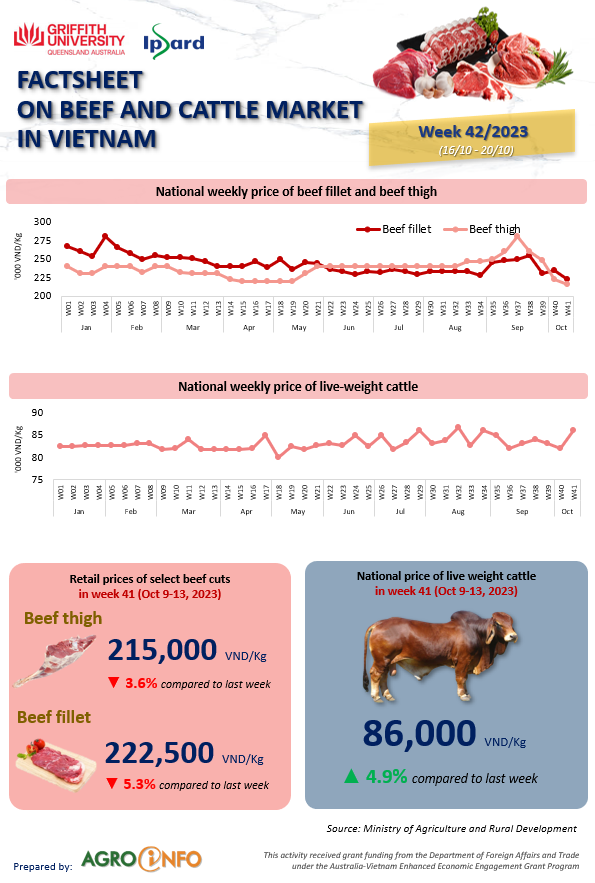


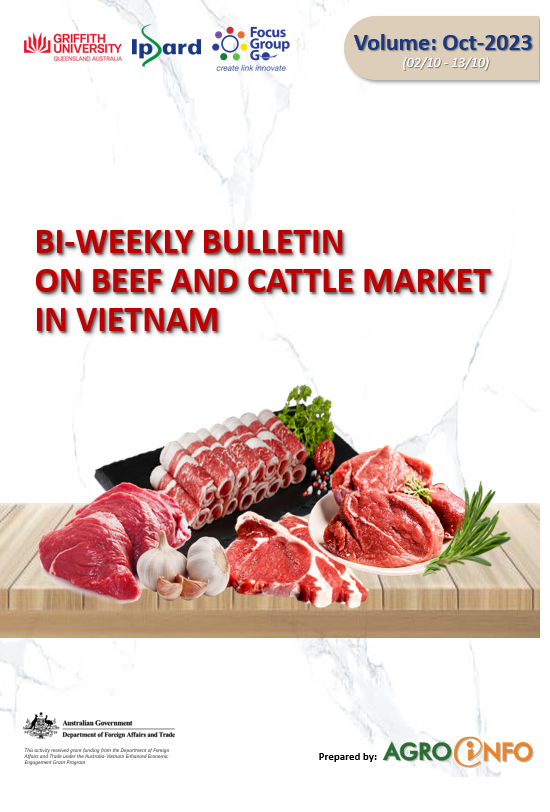

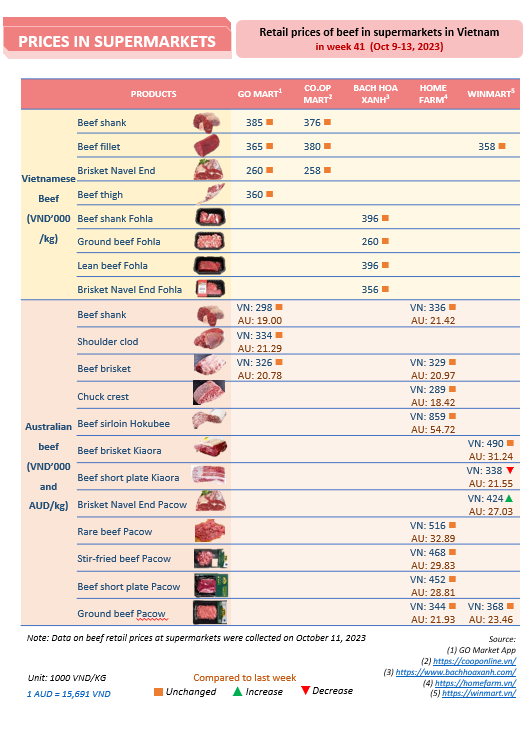
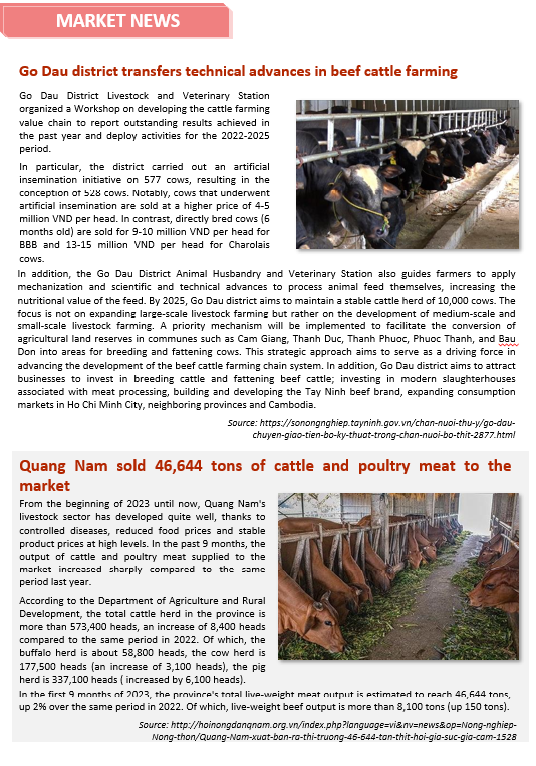



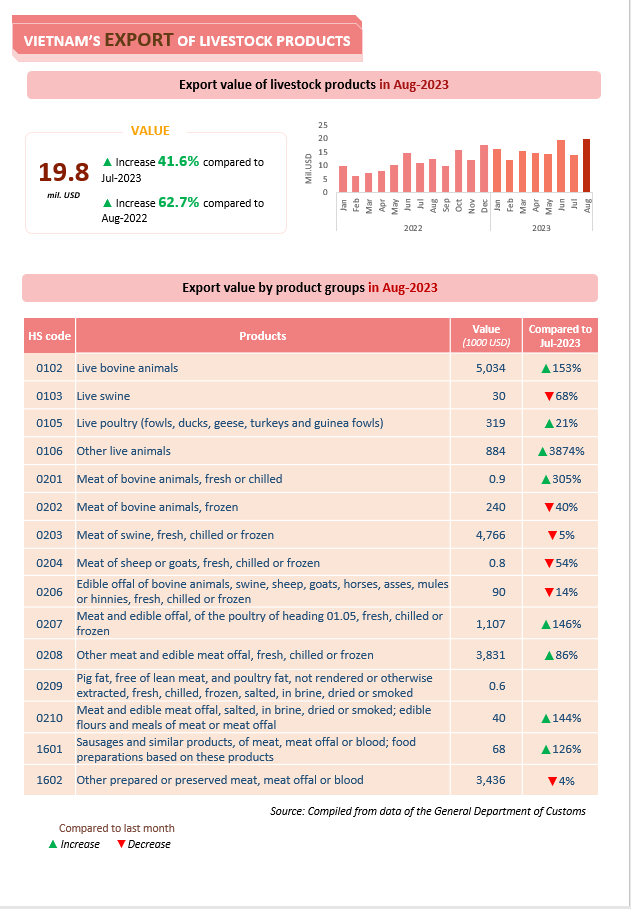
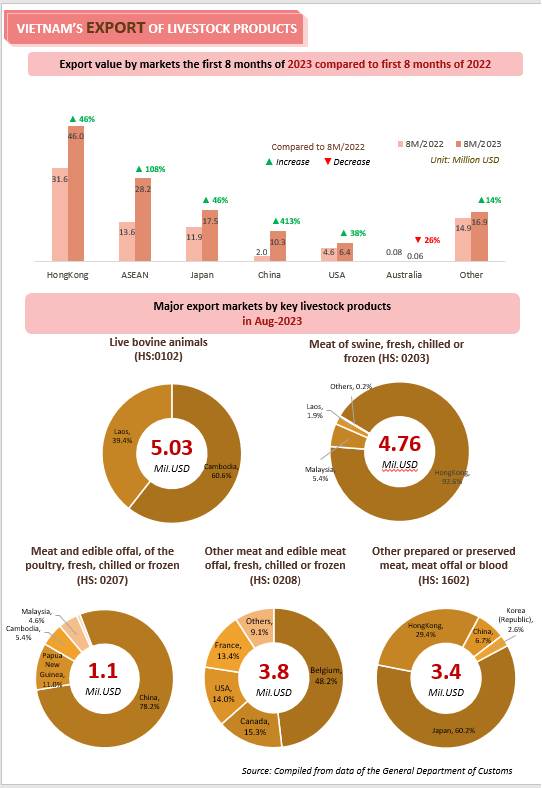
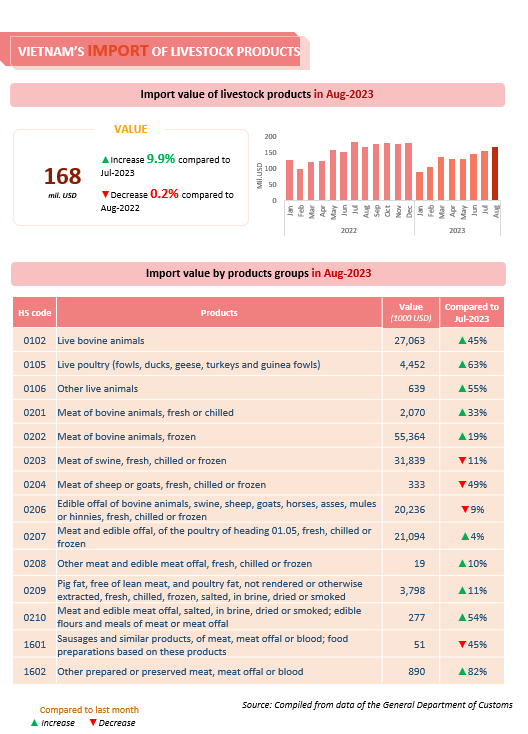
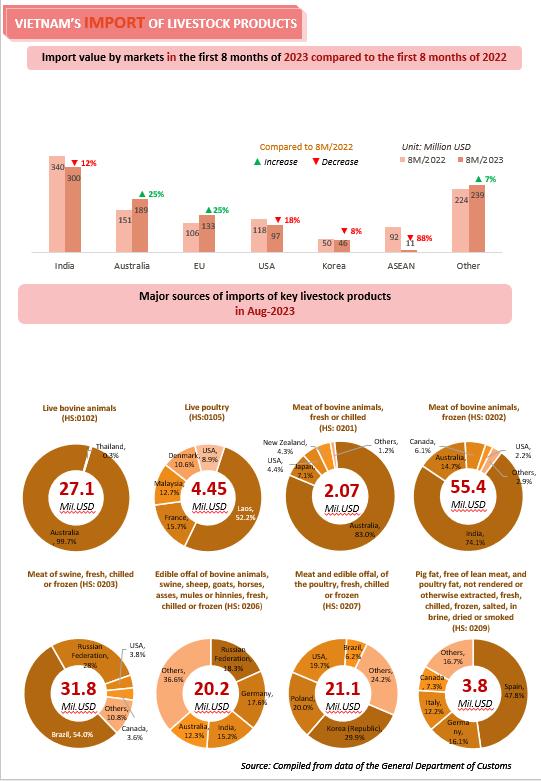


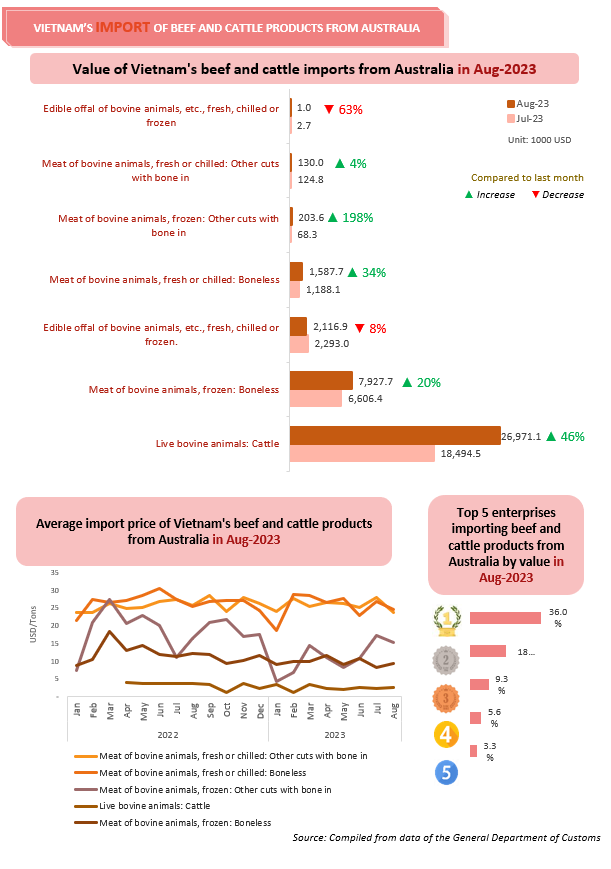
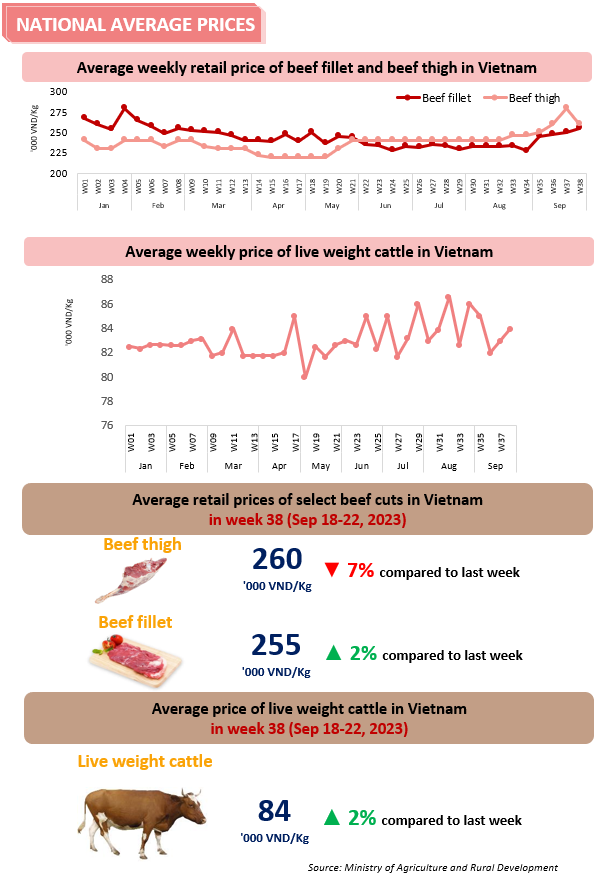
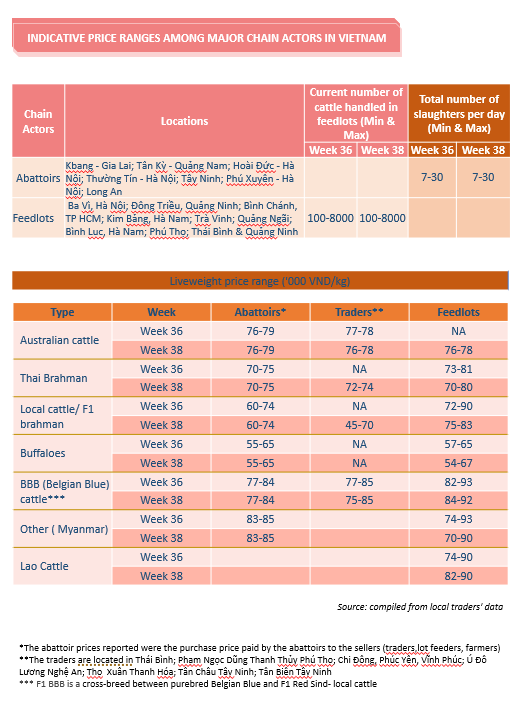
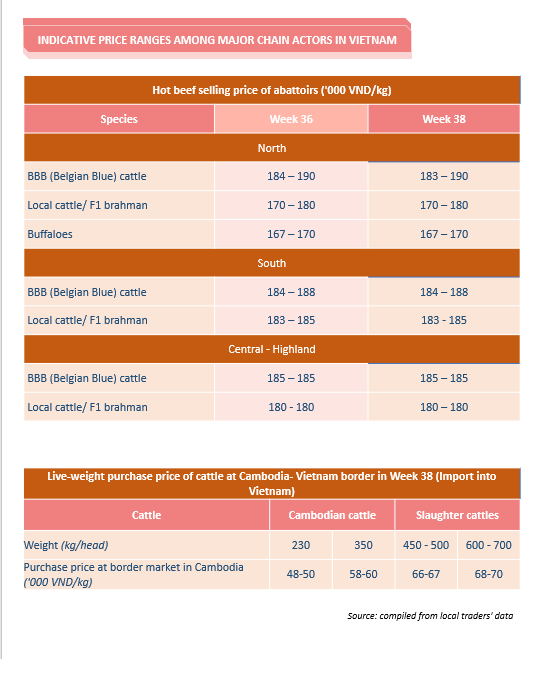


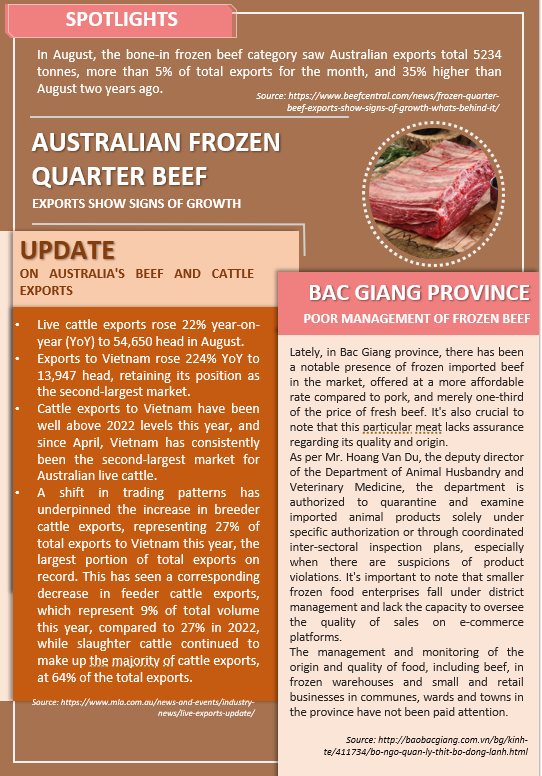


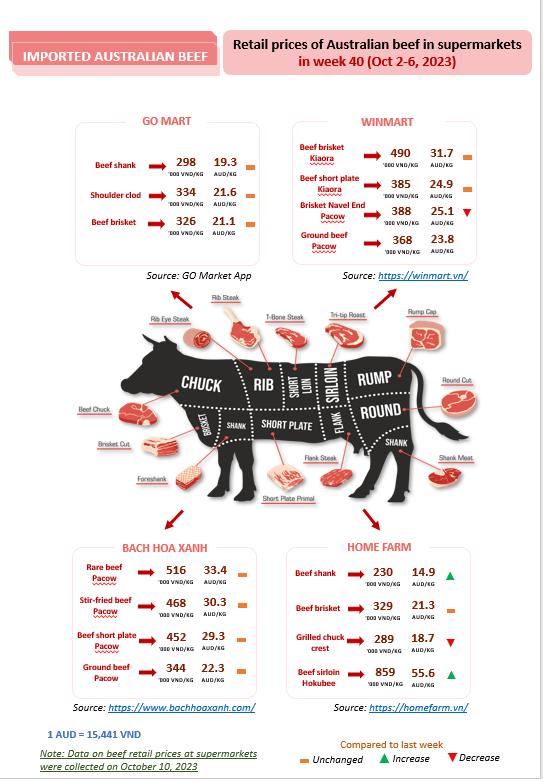
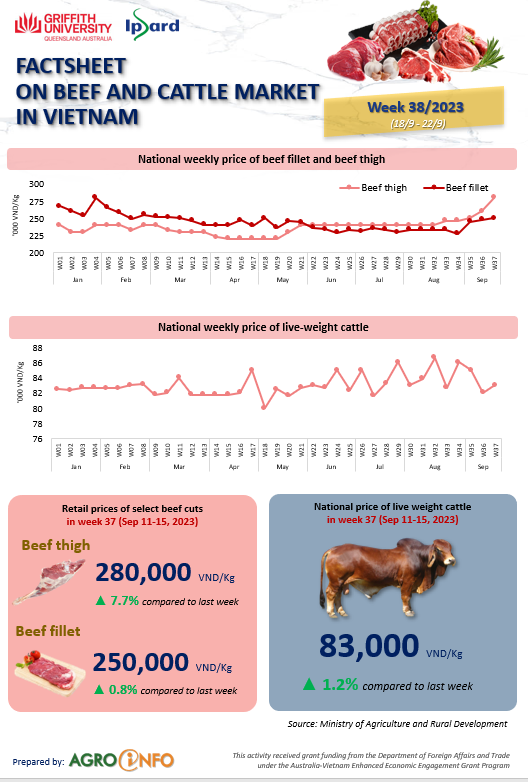

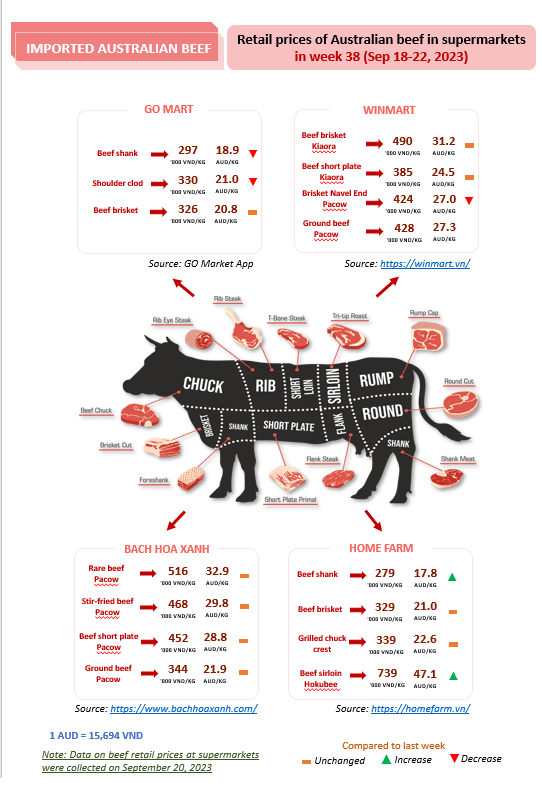
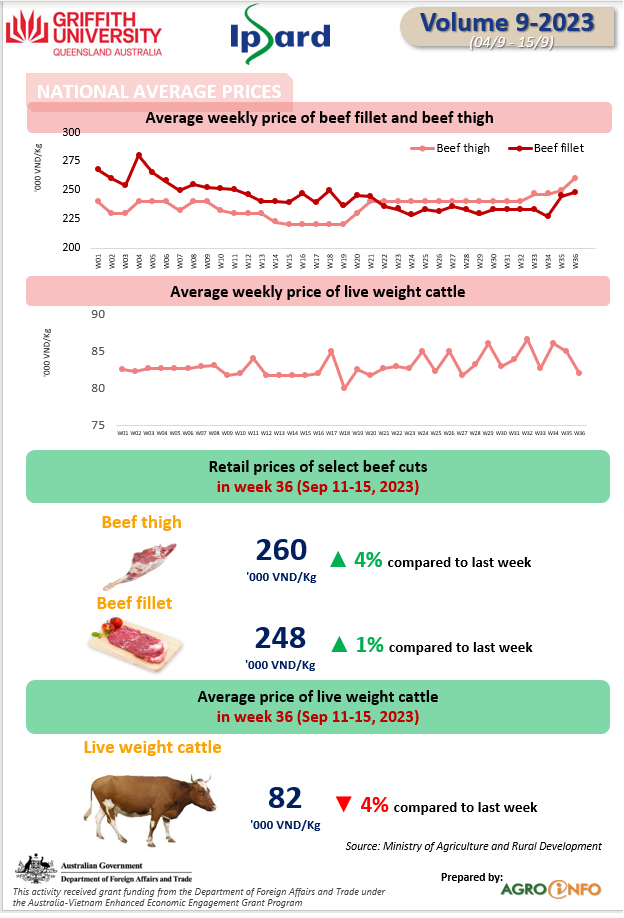


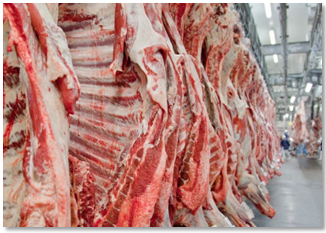

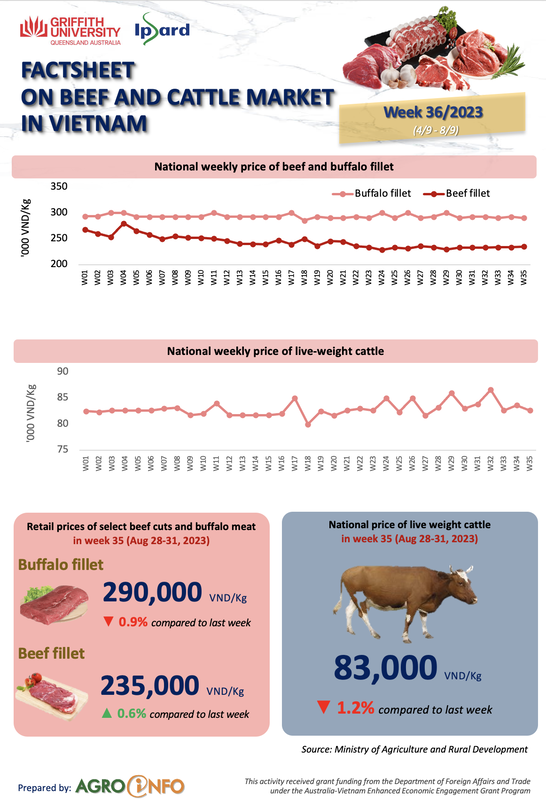
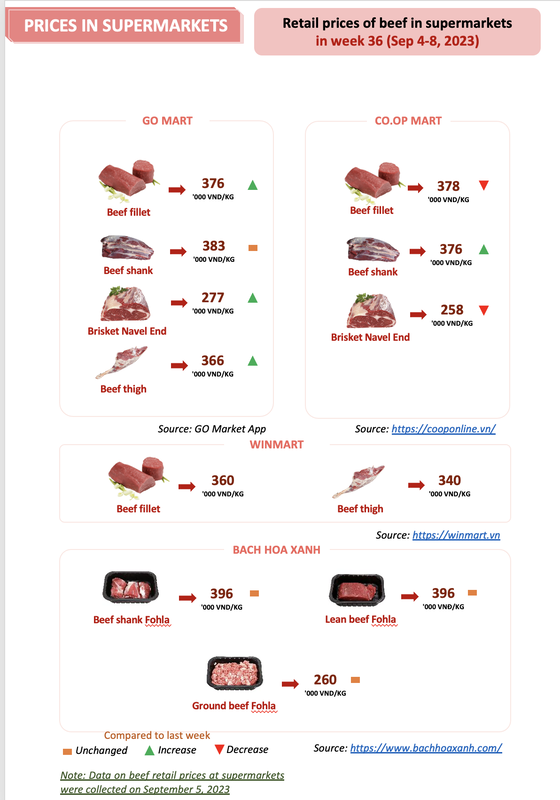
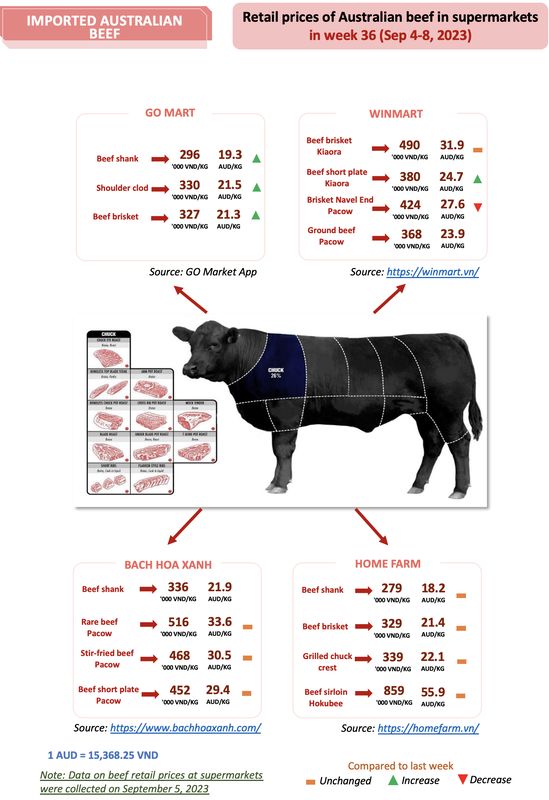
 RSS Feed
RSS Feed





